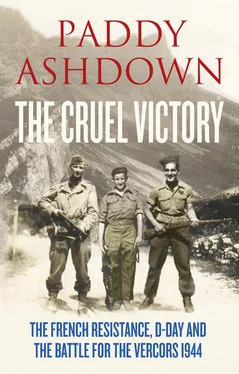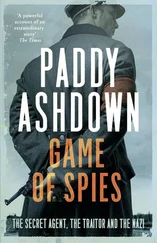This division is visible even in the vegetation and architecture of the two halves. Travel just a few tens of metres south through the short tunnel at the Col de Menée at the south-eastern edge of the plateau and there is a different feel to almost everything. Even the intensity of the light seems to change. Pine trees, temperate plants and solid thick-walled houses, whose roofs are steeply inclined for snow, give way almost immediately to single-storey houses with red-tiled roofs crouching against the summer heat, tall cypresses as elegant as pheasant feathers, the murmuring of bees and the scent of resin in the air. Here the hillsides are covered with wild thyme, sage and the low ubiquitous scrub called maquis , from which the French Resistance movement took its name.
Many factors and many personalities shaped the events which took place on the Vercors during the Second World War. One of them was the extraordinary, secluded, rugged, almost mythical nature of the plateau itself.
2
FRANCE FROM THE FALL TO 1943: SETTING THE SCENE
It is only the French themselves who understand fully the depth of the wounds inflicted by the fall of France in 1940. They had invested more in their Army than any other European nation with the exception of Germany. With around 500,000 regular soldiers, backed by 5 million trained reservists and supported by a fleet of modern tanks which some believed better than the German Panzers, the French Army was regarded – and not just by the French – as the best in the world.
It took the Germans just six weeks to shatter this illusion and force a surrender whose humiliation was the more excruciating because Hitler insisted that it took place in the very railway carriage where Germany had been brought to her knees in 1918. It is not the purpose of this book to delve in detail into how France fell. But one important element of those six weeks in the summer of 1940 is often overlooked. Not all of France’s armies were defeated.
The French Army of the Alps – the Armée des Alpes – never lost a battle. They held the high Alpine passes against a numerically superior Italian assault. And they stopped the German Army too, at the Battle of Voreppe, named for the little town just outside Grenoble which guards the narrows between the Vercors and the Chartreuse massifs. Indeed the Battle of Voreppe ended only when the French artillery, wreaking havoc on German tanks from positions on the northern tip of the Vercors plateau, were ordered to return to barracks because the ceasefire was about to come into force. Thanks to this action, Grenoble and the Vercors remained in French hands when the guns fell silent. But this was small comfort to the victorious French Alpine troops who now found that they were part of a humiliated army. They regarded themselves as undefeated by the Germans but betrayed by the Armistice and ached to recover their lost honour.
The French rout and the German columns pushing deeper and deeper into France set in train a flood of internal refugees who fled south in search of safety. It was estimated that some 8 to 9 million civilians – about a quarter of the French population – threw themselves on to the roads, seeking to escape the occupation. They were later referred to as les exodiens . Among them were 2 million Parisians, French families driven out of Alsace-Lorraine and many Belgians, Dutch and Poles who had made their homes in France.
The ceasefire between German and French troops came into force at 09.00 on 24 June 1940 and was followed by the Armistice a day later. Under the terms of this peace, France was divided in two. The northern half, known as the Zone Occupée or ZO, was placed under General Otto von Stülpnagel, named by Hitler as the German Military Governor of France. The southern half, the Zone Non-Occupée or ZNO, comprising about two-fifths of the original territory of metropolitan France, was to be governed by Marshal Pétain, who set up his administration in the central French town of Vichy. The two were separated by a Demarcation Line, virtually an internal frontier, which ran from the border with Switzerland close to Geneva to a point on the Spanish border close to Saint-Jean-Pied-de-Port.
Map 2
There was another France created by the nation’s defeat and humiliation, but very few knew about it at the time. It had left with General Charles de Gaulle in a British plane from Mérignac airport outside Bordeaux not long before the Armistice was signed. On 18 June 1940, just two days after he arrived in London, de Gaulle made the first of his famous broadcasts to the French people: ‘has the last word been said? … Is defeat final? No! Believe me, I who am speaking to you from experience … and who tell you that nothing is lost for France … For France is not alone! She is not alone! She is not alone! … This war is a world war. Whatever happens, the flame of the French resistance must not be extinguished and will not be extinguished.’ The sentences were stirring enough. The problem was, almost no one in France heard them. In the early 1940s there were only 6 million radios in France and, since a quarter of France’s population were in captivity, or fighting, or on the roads fleeing the invader, there were not many who had the time to sit at home with their ears glued to the radio, even if they had one.
With almost 70,000 casualties, 1.8 million of her young men in German prisoner-of-war camps and la gloire française ground into the dust alongside the ancient standards of her army, France’s first reaction to her new conqueror was stunned acquiescence. Early reports arriving in London from French and British agents all speak of the feeble spirit of resistance in the country. In these first days, many, if not most, of the French men and women who had heard of de Gaulle saw him as a rebel against the legitimate and constitutional government in Vichy. They trusted Pétain to embody the true spirit of France and prepare for the day when they could again reclaim their country. After all, was he not the hero of Verdun, the great battle of 1916? Some believed fervently that the old warrior’s Vichy government would become, not just the instrument for the rebuilding of national pride, but also the base for the fight back against the German occupier and that he, Pétain, the first hero of France, would become also the ‘premier résistant de la France’.
There were, of course, some who wanted France to follow Germany and become a fascist state. In due course they would be mobilized and turn their weapons on their fellow countrymen. But these were a minority. For the most part, after the turbulence and the humiliation, the majority just wanted to return to a quiet life, albeit one underpinned by a kind of muscular apathy. The writer Jean Bruller, who was himself a Resistance fighter and used ‘Vercors’ as his nom de plume , clandestinely published his novel Le Silence de la Mer in 1942. In this he has one of his characters say of France’s new German masters: ‘These men are going to disappear under the weight of our disdain and we will not even trouble ourselves to rejoice when they are dead.’
There were many reasons why, in due course and slowly, the men and women of occupied France broke free of this torpor and began to rise again. But two were pre-eminent: the burning desire to drive out the hated invader, and the almost equally strong need to expiate the shame of 1940 and ensure that the France of the future would be different from the one that had fallen.
The formation of the earliest Resistance groups came organically – and spontaneously – from French civil society. Some were little more than clubs of friends who came together to express their patriotism and opposition to the occupier. Others were political – with the Communists being especially active after Operation Barbarossa, Hitler’s invasion of Russia in June 1941. Almost all were strenuously republican in their beliefs. There were even Resistance organizations supporting the regime in Vichy, preparing for the day when they would help to recapture the Zone Occupée. Although the early Resistance groups concentrated mainly on propaganda through the distribution of underground newspapers, over time they evolved into clandestine action-based organizations capable of gathering intelligence, conducting sabotage raids and carrying out attacks on German units and installations.
Читать дальше












